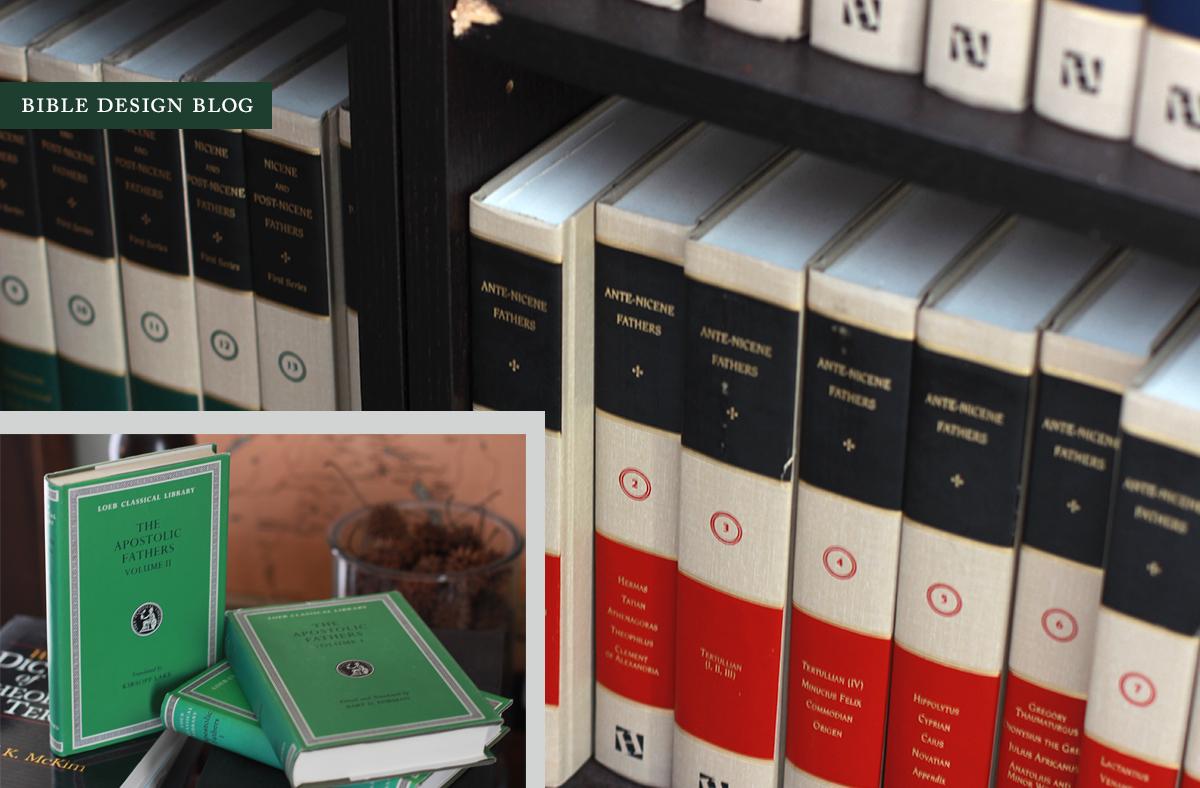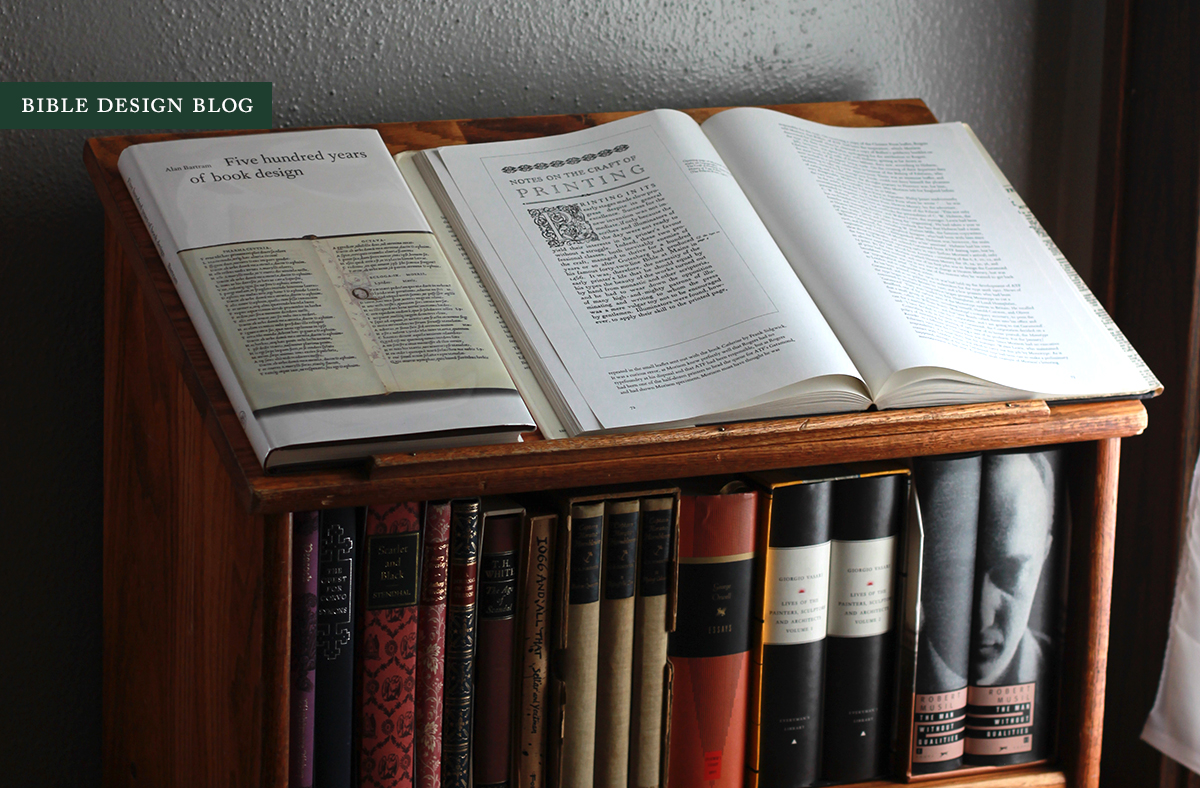Leatherbound Church Fathers, the Allan Ruby, and Standing Desks
Boy, do I get questions. My inbox is flooded, and it’s impossible to stay on top of everything. One of my resolutions for the year is to do a better job at providing answers. So here’s a new feature: from time to time (sometimes weekly, sometimes less frequently) I’m going to take common questions in groups of three. I will bundle some of the off-topic questions I frequently get with Bible-related ones so there’s something for everyone. Okay, here goes: LEATHER-BOUND CHURCH FATHERS Brandon Coffey asks: “I am trying to find if anyone out there produces nice, leather-bound editions of any of the early church writings. Specifically the Apostolic Fathers, or the rest of the Ante-Nicene writings.”
I’m starting with this because it’s a great example of the most common type of question I get: the kind I can’t answer. The sad fact is, I don’t know of any nice, leather-bound editions of the church fathers. The set on my shelf is the familiar hardcover range sold by CBD. The Loeb Classical Library is another source, and has the advantage of offering side-by-side Greek or Latin and English. You could have either of these rebound in leather. Does anyone know of other options?
SHOULD I BUY NOW OR WAIT AND SEE? Charles Jackson asks: “I was wondering if you have any information on the upcoming Ruby's from Allan. I am trying to decide whether to buy one of the older versions I see on some of the sites or hold out for the new batch coming out later.”
The best way to get information on upcoming editions from R. L. Allan is to reach out to them via their Facebook page. Insider info comes my way occasionally, but you’re always better off going to the source.
Having said that, here’s my advice for people struggling with variations on the “should I buy now or wait and see?” theme (which is a very common dilemma). Personally, I’d rather have the edition available today than the one that’s coming later. If the new version is so awesome I simply must have it, I deal with that problem as it arises. With tech products it makes sense to wait and see, giving developers an opportunity to the get the bugs out. Early adopters are often unwitting beta testers. That’s not usually the case with print Bibles. While popular editions often make incremental improvements when they are re-issued, they don’t typically improve so dramatically that people who have the older version feel like rushing out to upgrade. The exception? Those of us who have the collecting bug, and feel compelled to have the latest and/or best iteration.
STANDING DESKS Mark Levine asks: “Ever since college I have been fascinated with standing desks, and thus yours particularly jumped off the screen when I saw the picture of your desk in your office. Would you mind sharing where you got it? Was it purchased? specially made perhaps? It's a beautiful piece.”
It’s a question I get a lot. Rich Chel asked, too: “On your site you have a great looking piece of furniture. I need something like that as a sort of nightstand for night reading. It is a slanted stand/corner bed table. It looks like you could put a large dictionary or Bible on the slanted part. Do you know where I can get something similar?”
The standing desk you’ve seen pictured on Bible Design Blog is usually the Franklin Library Desk Stand from Levenger. It’s basically a lectern with a nifty magnifying glass on the shelf and a drawer underneath. For some reason they don’t seem to sell them anymore. I also use Levenger’s Editor’s Desk, a sloped surface with a shelf on top, which has the advantage of being portable — you can convert any surface into a sloped standing desk simply by placing the Editor’s Desk on top. Of course, they don’t seem to sell this one anymore, either. I bought mine on eBay.
Last summer, knowing my love for sloped book stands, Scott Kay, an old friend who pastors in Georgia and reads the blog, gave me a swivel stand from Brodart, which I now use on top of a vintage library desk (the kind with shelves built into the sides). Once people figure out you're a writer, they start giving you stuff like this. I love that.
A designer friend, Tim Murray, helped me build a proper standing desk for my office, scaled precisely for my height. (When I say “helped me build,” I mean that he did all the work while I stood by trying to look busy.) We used plywood and two-by-fours from the hardward store to keep costs down. This standing desk hovers above an old-fashioned heater in my office, allowing me to exercise dominion over what was previously wasted space. The Editor’s Desk sits on one side for working by hand, while my computers sit on the other (the laptop on the desk, the iMac at eye level).
This arrangement helps with my Bible Design Blog workflow, because I can lift the Editor’s Desk and use the end of my desk near the window to shoot photos in beautiful natural light. When I’m done, I put the Editor’s Desk back in place.
My wife Laurie found a workmanlike bookcase with a sloped top at a local antique store for about twenty bucks. It’s not quite tall enough for me to use as a standing desk, but it’s a great place to display books I want to consult. The lesson is, check eBay and keep watch at your local antique stores and thrift shops. Art supply houses are a good bet, too. If you’re at all handy, building your own is well within reach.




